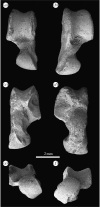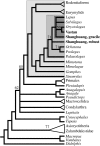Early Eocene lagomorph (Mammalia) from Western India and the early diversification of Lagomorpha
- PMID: 18285282
- PMCID: PMC2602686
- DOI: 10.1098/rspb.2007.1661
Early Eocene lagomorph (Mammalia) from Western India and the early diversification of Lagomorpha
Abstract
We report the oldest known record of Lagomorpha, based on distinctive, small ankle bones (calcaneus and talus) from Early Eocene deposits (Middle Ypresian equivalent, ca 53 Myr ago) of Gujarat, west-central India. The fossils predate the oldest previously known crown lagomorphs by several million years and extend the record of lagomorphs on the Indian subcontinent by 35 Myr. The bones show a mosaic of derived cursorial adaptations found in gracile Leporidae (rabbits and hares) and primitive traits characteristic of extant Ochotonidae (pikas) and more robust leporids. Together with gracile and robust calcanei from the Middle Eocene of Shanghuang, China, also reported here, the Indian fossils suggest that diversification within crown Lagomorpha and possibly divergence of the family Leporidae were already underway in the Early Eocene.
Figures




Similar articles
-
Stem Lagomorpha and the antiquity of Glires.Science. 2005 Feb 18;307(5712):1091-4. doi: 10.1126/science.1107808. Science. 2005. PMID: 15718468
-
Comparative morphology of premolar foramen in lagomorphs (Mammalia: Glires) and its functional and phylogenetic implications.PLoS One. 2013 Nov 21;8(11):e79794. doi: 10.1371/journal.pone.0079794. eCollection 2013. PLoS One. 2013. PMID: 24278178 Free PMC article.
-
A large mimotonid from the middle Eocene of China sheds light on the evolution of lagomorphs and their kin.Sci Rep. 2015 Mar 30;5:9394. doi: 10.1038/srep09394. Sci Rep. 2015. PMID: 25818513 Free PMC article.
-
LaGomiCs-Lagomorph Genomics Consortium: An International Collaborative Effort for Sequencing the Genomes of an Entire Mammalian Order.J Hered. 2016 Jul;107(4):295-308. doi: 10.1093/jhered/esw010. Epub 2016 Feb 26. J Hered. 2016. PMID: 26921276 Free PMC article. Review.
-
Low, complex and probably reticulated chromosome evolution of Sciuromorpha (Rodentia) and Lagomorpha.Cytogenet Genome Res. 2012;137(2-4):218-32. doi: 10.1159/000341379. Epub 2012 Jul 26. Cytogenet Genome Res. 2012. PMID: 22846378 Review.
Cited by
-
Geologically calibrated mammalian tree and its correlation with global events, including the emergence of humans.Ecol Evol. 2023 Dec 19;13(12):e10827. doi: 10.1002/ece3.10827. eCollection 2023 Dec. Ecol Evol. 2023. PMID: 38116126 Free PMC article.
-
The historical biogeography of Mammalia.Philos Trans R Soc Lond B Biol Sci. 2011 Sep 12;366(1577):2478-502. doi: 10.1098/rstb.2011.0023. Philos Trans R Soc Lond B Biol Sci. 2011. PMID: 21807730 Free PMC article. Review.
-
Suprafamilial relationships among Rodentia and the phylogenetic effect of removing fast-evolving nucleotides in mitochondrial, exon and intron fragments.BMC Evol Biol. 2008 Nov 26;8:321. doi: 10.1186/1471-2148-8-321. BMC Evol Biol. 2008. PMID: 19036132 Free PMC article.
-
Inferring ancestral states without assuming neutrality or gradualism using a stable model of continuous character evolution.BMC Evol Biol. 2014 Nov 28;14:226. doi: 10.1186/s12862-014-0226-8. BMC Evol Biol. 2014. PMID: 25427971 Free PMC article.
-
Contextualising primate origins--an ecomorphological framework.J Anat. 2016 Apr;228(4):608-29. doi: 10.1111/joa.12441. Epub 2016 Feb 2. J Anat. 2016. PMID: 26830706 Free PMC article. Review.
References
-
- Asher R.J, Meng J, Wible J.R, McKenna M.C, Rougier G.W, Dashzeveg D, Novacek M.J. Stem Lagomorpha and the antiquity of Glires. Science. 2005;307:1091–1094. doi:10.1126/science.1107808 - DOI - PubMed
-
- Averianov A.O. Tarsals of Glires (Mammalia) from the Early Eocene of Kirgizia. Géobios. 1991;24:215–220. doi:10.1016/S0016-6995(91)80009-O - DOI
-
- Averianov A.O, Lopatin A.V. Eocene lagomorphs (Mammalia) of Asia: 1. Aktashmys (Strenulagidae fam. nov.) Paleontol. J. 2005;39:308–317.
-
- Barry J.C, et al. Faunal and environmental change in the Late Miocene Siwaliks of northern Pakistan. Paleobiol. Mem. 2002;3:1–72. doi:10.1666/0094-8373(2002)28[1:FAECIT]2.0.CO;2 - DOI
-
- Beard, K. C. 1998 East of Eden: Asia as an important center of taxonomic origination in mammalian evolution. In Dawn of the age of mammals in Asia (eds K. C. Beard & M. R. Dawson). Bull. Carnegie Mus. Nat. Hist 34, 5–39.
Publication types
MeSH terms
LinkOut - more resources
Full Text Sources

